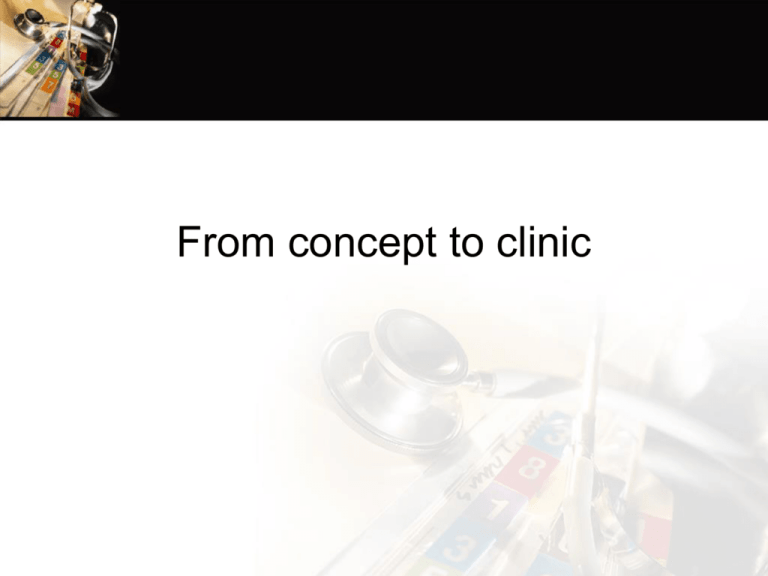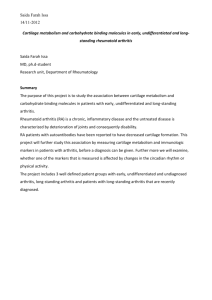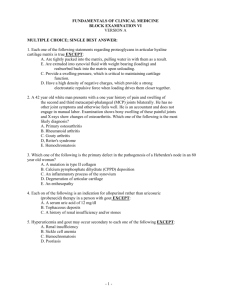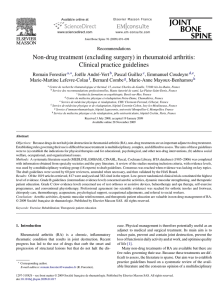Standardising terminology - Healthcare Conferences UK
advertisement

From concept to clinic Good …. but not enough • Standardisation of terms with SNOMED and ICD-10 coding provides shareable data but doesn’t retain the clinical insights and knowledge required for: – Stratified medicine – Specialised commissioning – Genomic medicine Stratified medicine The treatment for this instance of rheumatoid arthritis occurring in a patient with these characteristics The treatment for rheumatoid arthritis Will require very large sets of well organised, routinely collected clinical data Information loss • Reducing a diagnosis to a single piece of data, however coded, removes almost all clinical insights A diagnosis cluster with SNOMED CT coding Seropositive rheumatoid arthritis SCTID:239791005 Autoimmune disorder SCTID:8582009 Rheumatoid arthritis SCTID:69896004 Arthritis SCTID:3723001 Seronegative rheumatoid arthritis SCTID:239792003 Adding clinical insight Lung cancer Smoking related disease High cost drug disease Disease associated with increased cardiovascular mortality Rheumatoid arthritis Adding clinical insight Lung cancer Smoking related disease High cost drug disease Disease associated with increased cardiovascular mortality Rheumatoid arthritis Concept map of arthritis Adding clinical insight Lung cancer Smoking related disease High cost drug disease Disease associated with increased cardiovascular mortality Rheumatoid arthritis Capturing phenotype • Phenotype definition: – The set of observable characteristics of an individual or a disease • For an individual: – Body shape – Skin colour – (Lifestyle choices) • For a disease: – Which manifestations of the disease are present or absent? – How severe or active are those manifestations? Capturing phenotype – how not to do it • Any attempt to represent subgroups of complex diseases with single codes will fail. • Example: A disease has eight individual, mutually independent manifestations each of which can be present or absent. • It follows, therefore that there are 28 (= 256) different phenotypic subsets for that disease and that the required coding set will be too large to manage. • Disease and phenotype must be separated An ORCHID Core Data Set Diagnosis + core + longitudinal data Seropositive rheumatoid arthritis Drug monitoring: FBC LFTs U&Es Disease monitoring: DAS 28 HAQ CRP ORCHID Class Hierarchies • ORCHID class hierarchies are Directed Acyclic Graphs • Used for diagnosis, medications, laboratory tests, etc • Three-level, with Core Data Sets to represent phenotypes • Nodes can also carry clinical coding (SNOMED, ICD-10, etc) Data Dictionary • The Data Dictionary combines ISO-13696 and HL7 CDA structures • Elements • Clusters of Elements • Entries • Arranged (reused) in – Sections – Compositions (HL7 CDA Document) • Messages • Views • Forms Assessments – Graphical Entry Graphical Entry of Fracture Record In conclusion • Electronic health records will provide unprecedented opportunities to exploit routinely collected clinical data for many purposes • We can only take advantage of the opportunities presented by EHRs if we develop standardised data sets mapped to appropriate codings • SNOMED CT is conceptually rich but needs content improvement and ongoing ownership and stewardship of specialty reference sets • Optimum use of clinical data requires complex information models linked to simple user interfaces • Clinicians working with specialist societies and their Royal Colleges must play a central role in these developments











